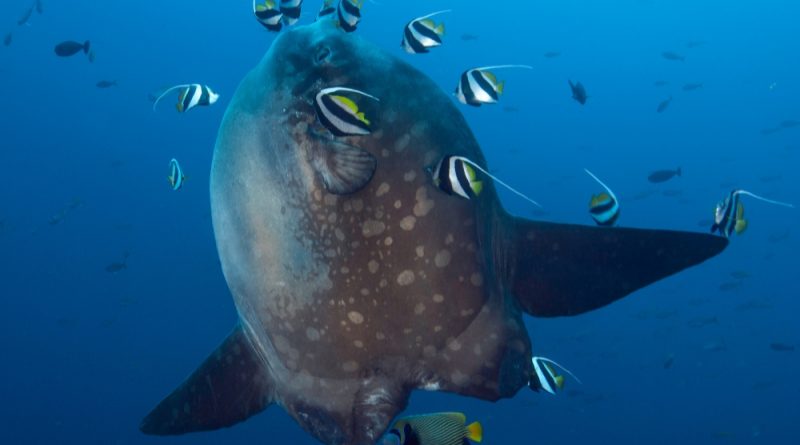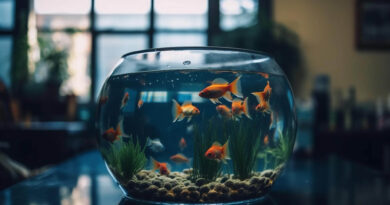Moonfish: What is it and where does this species live?
Marine fauna is represented by thousands of species worldwide, and as more research is conducted, findings are astonishing. Within this diversity, we find fish, which are divided into three major groups. One of these corresponds to bony fish, which have a higher degree of calcified structures in their skeleton and a lesser amount of cartilage, hence their name. A species that belongs to them is commonly known as the moonfish, which has very peculiar characteristics that make it unique in the oceans it inhabits.
Be sure to read this interesting article from Perito Animal so that you can learn all the characteristics of the moonfish, where it lives, what its habits are, and much more.
Taxonomic classification of the moonfish
The moonfish is taxonomically classified as follows:
- Kingdom: Animal
- Phylum: Chordates
- Class: Actinopterygii
- Order: Tetraodontiformes
- Family: Molidae
- Genus: Mola
- Species: Mola mola
Moonfish species
The common name of this fish is associated with the rounded and flattened shape of its body. There are other species within this genus that are generally also called moonfish. Initially, two were identified, but later three were named for the Mola genus, which, in addition to the one mentioned, are:
- Mola alexandrini
- Mola tecta
Below are some photos of the moonfish from each species:
Characteristics of the moonfish
Let’s explore the aspects that characterize the moonfish:
- The moonfish is one of the largest bony fish in the world, which is undoubtedly one of the features that make it very peculiar.
- An adult moonfish can measure about 3.1 meters in length and 4.26 meters in height. Regarding weight, it is surprising, as it can reach up to 2.3 tons, which is the maximum reported weight.
- There is sexual dimorphism in the species, as females are larger than males.
- Another particular aspect of the moonfish is that it lacks scales; its skin is thick and has a rubbery texture, with irregular tooth-like spots on the body.
- Although it can vary in coloration, generally, it is in shades of light and dark gray, brown, and white.
- As for the large dorsal and anal fins, they also have peculiar characteristics since it lacks a caudal fin and peduncle. Instead, it has a fan-shaped structure called clavus, representing a tail adapted for propulsion.
- It has large dorsal and anal fins, while the pectoral fins are, on the contrary, small.
- Its mouth is small and beak-shaped, due to its closely fused teeth.
- This fish can swim at high speeds and poses no danger to humans.
Where does the moonfish live?
The habitat of the moonfish is very varied because it is a cosmopolitan species. It lives in all oceans, both temperate and tropical, so it is found in the Atlantic, Indian, and Pacific Oceans. Similarly, it is found in the Mediterranean Sea. It prefers open waters, but to clean itself of certain parasites, it moves to coral areas or areas with algae formations, where it establishes a beneficial relationship with fish from the wrasse group, which rid it of parasitic species.
It is common to observe it when the water temperature ranges from 13 to 17 ºC, in places like California, Indonesia, the British Isles, islands in the northern and southern New Zealand, southern Africa, and also in the Mediterranean.
It can thrive in a range from 30 to 480 meters deep; however, it is usually more commonly found between 30 and 70 meters. Despite marine currents, it can move both horizontally and vertically, thanks to the use of its fins.
Moonfish: What is it and where does this species live? Diet:
The moonfish is a carnivorous species that feeds on:
- some types of other fish
- animals that make up zooplankton, such as ctenophores and salps
- some jellyfish
- crustaceans
- mollusks
- brittle stars
- larvae
Despite the above, it also includes algae in its diet.
The idea has been suggested that this fish makes migratory movements to latitudes where there is a higher concentration of zooplankton, especially during spring and summer. It is also suspected that it moves towards the surface to capture animals that mainly develop in that area, such as some jellyfish and smaller species it feeds on.
How is the reproduction of the moonfish?
Studies are lacking to know more about the reproductive biology of the moonfish. However, one of the particular aspects of this species is its incredible difference in size from birth to adulthood. A female can produce up to 300 million tiny eggs per reproductive season, which usually have a diameter of 0.13 cm. From these, larvae emerge that are 0.25 cm long, which go through two states:
In the first, they have a rounded shape and have spines projecting from the body; they also have a tail and developed caudal fin.
In the second, some changes occur, including the absorption of the tail and the loss of spines.
As mentioned, more studies on the reproduction of the moonfish are needed; however, estimates indicate that its development occurs rapidly, with an average of 0.02 to 0.42 kg of growth per day, and in some cases even more.
A curiosity about them is that female moonfish are considered the most fertile vertebrates that exist, due to the large oviposition they perform. In captivity, their lifespan is around 8 years. Based on estimates, it is believed that they live between 20 and 23 years in their natural habitat. Without a doubt, this is a surprising fact about the moonfish that should make us think about the importance of keeping these animals, and all, in their natural habitat.
Conservation status of the moonfish
The International Union for Conservation of Nature has classified the moonfish in the vulnerable category regarding the possibility of extinction, with a decreasing population trend. This is not a commercially important fish, although in Japan and Taiwan, there is a market for it, despite reports that it is a poisonous animal.
However, there is a high percentage of accidental captures in various oceanic regions where various types of fishing, such as trawling, drift nets, and longlines, are practiced as means of capturing the moonfish. Estimates indicate a global decrease of 30% in the species.
Regarding conservation plans for the species, so far, there are only reports that a law was created in Morocco to gradually eliminate the use of nets that accidentally capture this species. It has also been recommended to expand studies on its biology.
Now that you know everything about the moonfish with its main characteristics, don’t miss this other article where we talk about the rarest fish in the world.
If you enjoyed the article “Moonfish: What is it and where does this species live?”, share this curiosity with your friends and family about this very peculiar specimen.




